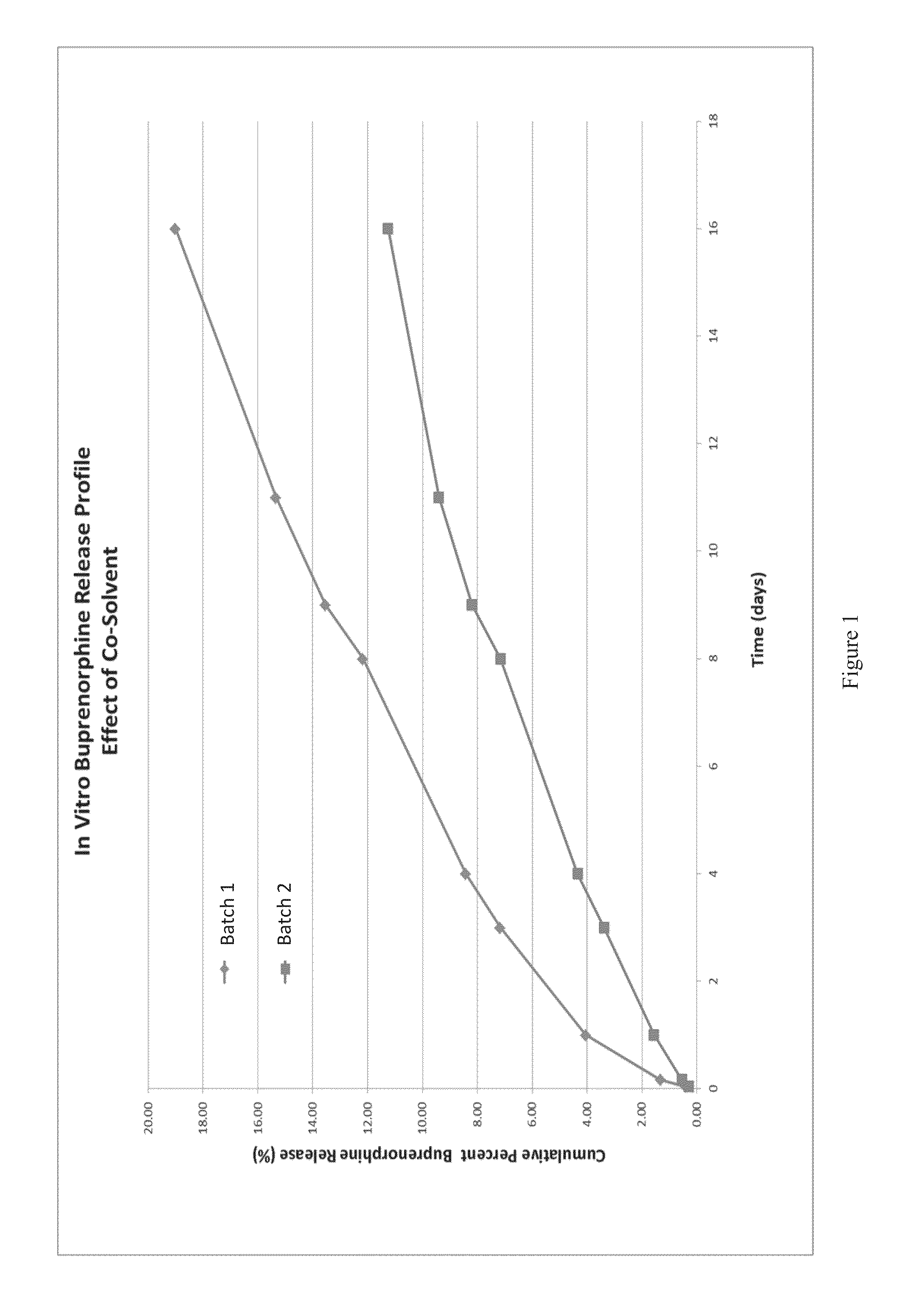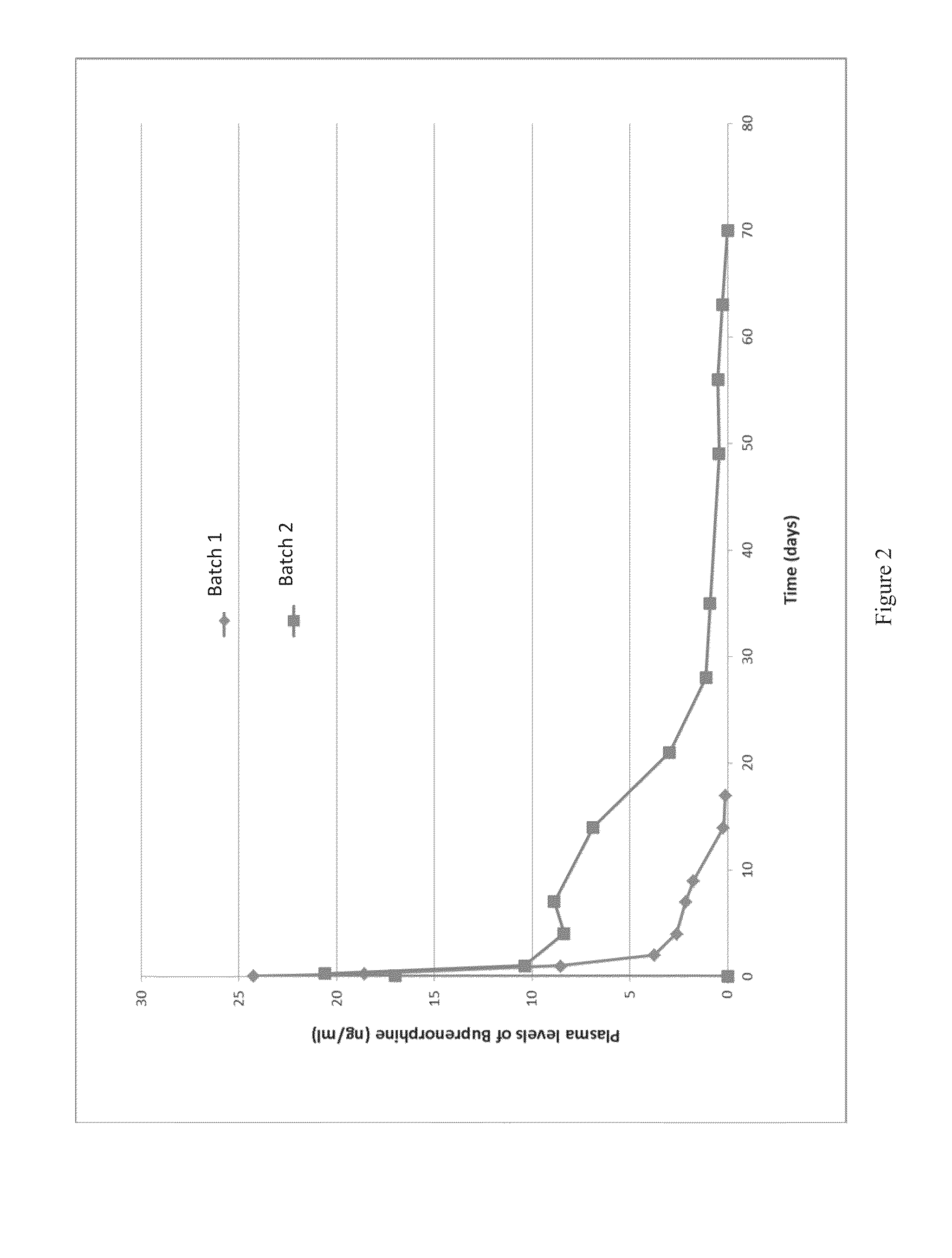High drug load buprenorphine microspheres and method of producing same
a buprenorphine and target load technology, applied in the field of high drug load buprenorphine microspheres and the method of producing them, can solve the problems of patient compliance and abuse potential, difficult to administer, and difficult to maintain the long-term maintenance treatment through this route, so as to achieve high target load microspheres, the amount of continuous phase required is very high, and the amount of dcm required to keep buprenorphine solubilized in the dispersed
- Summary
- Abstract
- Description
- Claims
- Application Information
AI Technical Summary
Benefits of technology
Problems solved by technology
Method used
Image
Examples
example 1
[0027]The solubility of buprenorphine in various solvents was determined by adding 0.5 g of buprenorphine into a 20.0 mL glass vial and dissolving it in increasing volumes of solvent until solubility was achieved by visual observation. DCM was used as the main solvent and BzOH as the co-solvent. An equal amount of D,L-PLA was then added to each vial to confirm that the solubility of the drug in the solvent system was not compromised by the introduction of the polymer. As shown below in Table 1, the addition of BzOH to the DCM increased the solubility of buprenorphine by about six (6) fold.
TABLE 1BuprenorphineCo-solventSolubility (g / g) in(% added byBuprenorphinepresence of equalSolvent Systemvolume)Solubility (g / g)amount of PLADCMNone0.0220.022Benzyl alcohol0.1250.125(33%)
example 2
Preparation of Buprenorphine Microspheres
[0028]The buprenorphine microsphere formulation may generally be prepared using a continuous W / O emulsification / solvent extraction procedure. Generally, a dispersed phase is provided by dissolving a polymer in a primary solvent, such as DCM, and a co-solvent capable of increasing the solubility of buprenorphine, such as BzOH. Buprenorphine is then added to the polymer solution and mixed until dissolved. The dispersed phase is then filtered using a 0.2 micron sterilizing PTFE or PVDF membrane filter (such as EMFLON, commercially available from Pall) and pumped into a homogenizer, such as an in-line Silverson Homogenizer (commercially available from Silverson Machines, Waterside UK), at a defined flow rate.
[0029]Simultaneously, a continuous phase including an aqueous solution containing a surfactant, such as polyvinyl alcohol (PVA), is also pumped into the homogenizer at a defined flow rate. The speed of the homogenizer is generally fixed to ac...
example 3
Effect of Co-Solvents
[0036]Generally, the solvent in the dispersed phase has to be extracted in order to form microspheres. Without the use of the co-solvent, the amount of DCM required to keep buprenorphine solubilized in dispersed phase is very high, especially in order to achieve high target load microspheres. Therefore, the amount of continuous phase required will be very high, as compared to a microsphere formation made with a co-solvent. For example, as discussed above, the solubility of buprenorphine in dichloromethane is 0.022 g / g. By using a 2:1 mixture of DCM:BzOH, the solubility of buprenorphine increased about 6 fold to 0.125 g / g. Thus, incorporation of a co-solvent reduces the amount of continuous phase needed by about 6 fold and allows for larger batch sizes to be produced while keeping the volumes of the continuous and dispersed phases lower.
[0037]In this example two batches of microspheres were prepared. For the first batch, a 9.1 wt % polymer solution was prepared b...
PUM
| Property | Measurement | Unit |
|---|---|---|
| Fraction | aaaaa | aaaaa |
| Fraction | aaaaa | aaaaa |
| Fraction | aaaaa | aaaaa |
Abstract
Description
Claims
Application Information
 Login to View More
Login to View More - R&D
- Intellectual Property
- Life Sciences
- Materials
- Tech Scout
- Unparalleled Data Quality
- Higher Quality Content
- 60% Fewer Hallucinations
Browse by: Latest US Patents, China's latest patents, Technical Efficacy Thesaurus, Application Domain, Technology Topic, Popular Technical Reports.
© 2025 PatSnap. All rights reserved.Legal|Privacy policy|Modern Slavery Act Transparency Statement|Sitemap|About US| Contact US: help@patsnap.com



